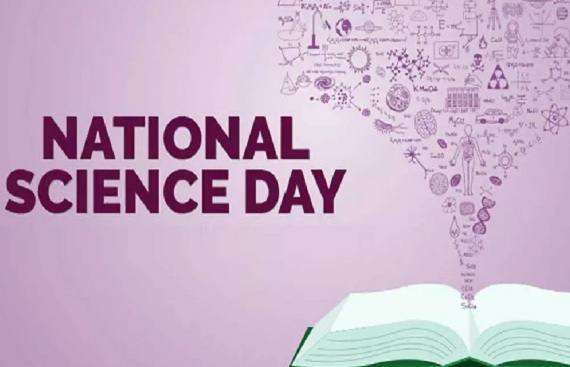National Science Day: A warm greeting to Science Fraternities

National Science Day is celebrated every year to honour the birth anniversary of Indian scientist Dr. Sir CV Raman. Let's remember the great physicist and Bharat Ratna Sir CV Raman and his discovery of the Raman Effect & monumental contributions to the science.
CV Raman Sir's earliest researches were in optics and acoustics, where he dedicated his entire career being a student on these two fields. Since, at that time, a scientific job did not seem to present the best possibilities, Raman entered the Indian Finance Department in 1907. However, the duties of his office took most of his time. CV Raman Sir found opportunities to carry on experimental analysis in the Indian Association for the Cultivation of Science laboratory at Calcutta, where he became Honorary Secretary in 1919.
In 1917 he was offered the newly endowed Palit Chair of Physics at Calcutta University and accepted it. After 15 years at Calcutta, he evolved a Professor at the Indian Institute of Science at Bangalore (1933-1948).
![]()
Since 1948 he has been Director of the Raman Institute of Research at Bangalore, founded and endowed by him. He also established the Indian Journal of Physics in 1926, of which he is the Editor. Since its inception, Raman sponsored the Indian Academy of Sciences establishment and has acted as president. He also initiated the proceedings of that academy, in which most of his work has been printed.
Some of Sir CV Raman's early biographies appeared as bulletins of the Indian Association for the Cultivation of Science (Bull. 6 and 11, dealing with the "Maintenance of Vibrations"; Bull. 15, 1918, dealing with the theory of the musical instruments of the violin family). He contributed an article on musical instruments to the 8th Volume of the Handbuch der Physik, 1928. In 1922 he published his work on the "Molecular Diffraction of Light," the first of a series of investigations with his collaborators which ultimately led to his discovery, on February 28, 1928, of the radiation effect which takes his name ("A new radiation," Indian J. Phys., 2 (1928) 387), and which achieved him the 1930 Nobel Prize in Physics.
Other investigations taken out by Raman were his experimental and theoretical studies on the diffraction of light by acoustic waves of ultrasonic and hypersonic frequencies published in 1934-1942 and those on the effects created by X-rays on infrared vibrations in crystals exposed to ordinary light. In 1948 Raman, through analysing the spectroscopic behaviour of crystals, then come fundamental problems of crystal dynamics in a new manner. His laboratory has been dealing with the structure and properties of the diamond the structure and optical behaviour of numerous iridescent substances (labradorite, pearly felspar, agate, opal, and pearls).
Along with Dr. Sir CV Raman, Dr. Vikram Sarabhai and Dr. Homi Jehangir Bhabha have equally contributed to the world of science and need to be remembered today.
Contribution of "Rocket Boys"
![]()
In recent days, the phrase "Rocket Boys" has been synonymous with the mega-hit web series that tells the story of Dr. Homi Jehangir Bhabha, who is deemed the architect of India's nuclear energy programmes, and Dr. Vikram Sarabhai, who is considered the father of India's space programme. They both contributed in making science a topic of drawing-room conversation. The two highly respected and self-motivated men joined forces to formulate India's space program. On National Science Day, here is a look at India's original 'Rocket Boys' lives.
Born into a prominent Parsi family in Mumbai, Dr. Homi J Bhabha is the "Father of India's Nuclear Science Programme." He established the Tata Institute of Fundamental Research (TIFR) in Mumbai in 1945. Three years later, he proposed forming the Atomic Energy Commission in India. With a go-ahead from then Prime Minister Jawaharlal Nehru, the body was set up, and Dr. Bhabha was made chairman. For his contribution to science and engineering, he was awarded the country's highest civilian award, Padma Bhushan, in 1954. He also presided over the first United Nations Conference on the peaceful uses of Atomic Energy. He died in an air crash in Switzerland in 1966.
![]()
Dr. Vikram Sarabhai is the award-winning physicist, who established Indian Space Research Organisation (ISRO). The premier institute was initially called the Indian National Committee for Space Research when it was started in 1962 and later renamed ISRO.
He received tremendous help and support from Dr. Bhabha in his endeavors. Dr. Bhabha assisted Sarabhai in setting up the country's first rocket launching station near Thiruvananthapuram, with advanced infrastructure, skilled staff, and launch pads. Its first flight took off on November 21, 1963.
Dr. Sarabhai was born in an affluent family of industrialists on August 12, 1919, in Gujarat's Ahmedabad. He joined the Gujarat Arts and Science College before graduating from Cambridge University with a doctorate.
He was honoured with Padma Bhushan in 1966. Padma Vibhushan, India's second-highest civilian award was granted in 1972 after his death.
Government’s Initiatives on National Science Day
The Government is organizing a Science Week, ‘Vigyan Sarvatra Pujyate,’ as a preamble to National Science Day. The programme appears to have been designed to make the youth proud of India’s scientific achievements. Using this opportunity as the nationalist mission is rather unfortunate. On the contrary, this event must be celebrated in the true spirit of science that defies all types of intellectual curtailments, thus promoting critical thinking in academic centers.
